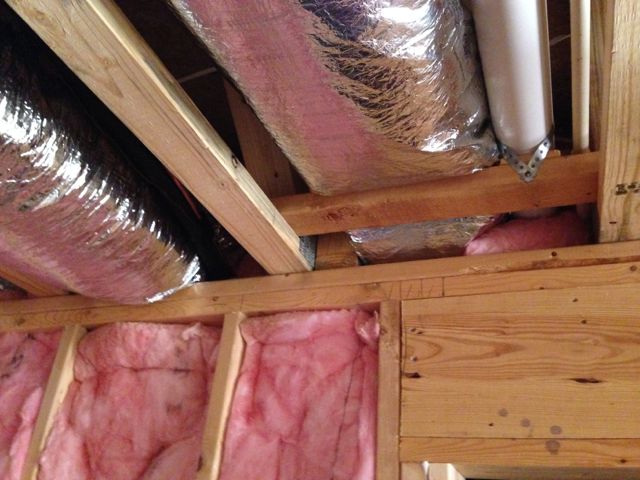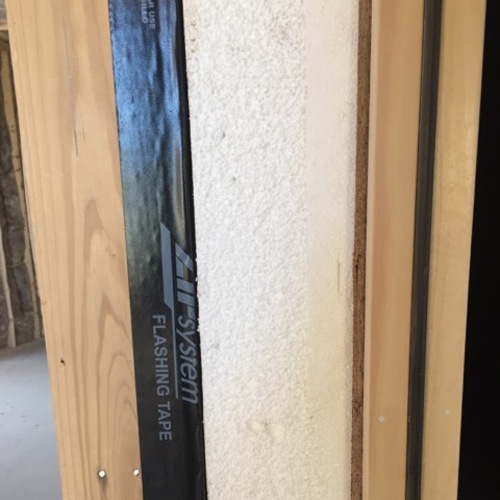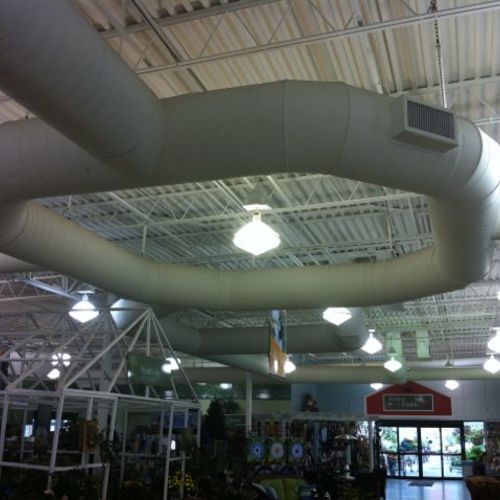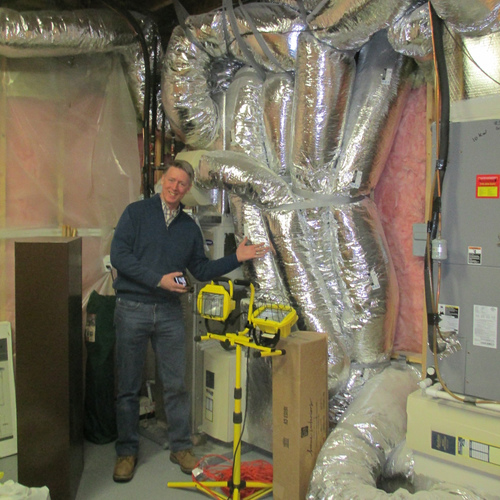
Image Credit: Energy Vanguard
The photo at right shows a common problem in new homes. It’s also one that can make it difficult to pass the blower door test required by many building codes these days. If I tell you that the wall pictured here separates two rooms in a basement and one of them is not conditioned, can you see the problem? If so, how many mistakes do you see here?
The building enclosure is the boundary between inside and outside. It separates conditioned space from various types of unconditioned space. In the case of the wall above, it separates the conditioned part of a basement from a mechanical room with three atmospheric combustion appliances — two 80 AFUE furnaces and a natural-draft water heater, all of which burn natural gas.
Since atmospheric combustion appliances draw their combustion air from the room they’re in, they need an adequate supply of air. The room behind that wall has a 12-inch duct designed to bring combustion air from the outdoors directly into that room. (How well it actually does that is a topic for another article.)
Ignoring the Grade III fiberglass insulation in the wall, the air barrier problems are in the joist area above the wall. These problems are:
The way this part of the building enclosure is constructed is pretty near impossible to fix after the fact, especially with flex duct running through the joists. What would have worked is to put in a rigid air barrier before running the ducts or plumbing and telling every trade contractor who cuts a hole to make sure they seal it.
And the HVAC contractor would need to do more than just cut a hole and run the flex straight through. The movement of the flex would eventually defeat the air sealing, so they’d need to install a rigid connector through the rigid air barrier and connect the flex to either side of it.
As this home has been built, the mechanical room on the other side is not going to have a hope of being the “sealed combustion closet” that it needs to be.
Allison Bailes of Decatur, Georgia, is a speaker, writer, energy consultant, RESNET-certified trainer, and the author of the Energy Vanguard Blog. Check out his in-depth course, Mastering Building Science at Heatspring Learning Institute, and follow him on Twitter at @EnergyVanguard.
Weekly Newsletter
Get building science and energy efficiency advice, plus special offers, in your inbox.















11 Comments
Sealed combustion closet??
How about some sealed combustion equipment instead?
What David said....
It should cheaper to just go with sealed combustion equipment with dedicated ducted combustion air direct to the appliance than it is to design & properly build a sealed mehcanical room with dedicated combustion air for the room, using atmospheric drafted or power vented equipment that isn't sealed-combustion.
Storm Shelter
Perhaps, but most people use this area as a safe room in storm alleys, although most are not since the roof is wood usually trusses. Most floors don't blow in storms (200+ mph) winds IF the basement windows are look out vs view out....The best protection is a concrete ceiling, sealed to the walls. You will need air in and out, perhaps a good place for an HRV line. I guess a pressure bulkhead ceiling with sealed duck flanges, but one would probably need to have designed in some head height and access, or rigid elbow(s), tees, unions, etc...to attach to.
A fridge, wet bar, big screen would be nice too ;)
Response to Terry Lee
Terry,
I'm not sure what your meditations on storm shelters and safe rooms has to do with the topic of this blog...
I am confused. Why is the
I am confused. Why is the "sealed combusiton closet" not a conditioned space as well; with the same envelope treatment as the rest of the house, other than a piped in air supply to the burner area. I bring fresh air directly to my dryer so it does not use up conditioned air; I bring freah air to my woodstove so it does't use up conditoned air: they are in the house's contigious, conditoned space.
Terry ...
might i add..
Duck and Cover !
Sealed?
Jin got it, but duct is spelled with a ‘t’ ;)
Marin, sorry to confuse you. The Architect in me is always looking for ways to consolidate, after decades of it.
We may be silly here in the mid-west compared to you east coasters but, our utility rooms also function as storm shelters and storage areas and are always conditioned. I was responding to the cost aspect of “sealed combustion appliance vs sealed utility room” noting some other perks to the latter. The utility rooms here have the furnace, sump pump, water heater, pex manifold, under stairs storage. There is usually a rim joist that is envelope and needs to be sealed.
Most builders have homeowners fooled though, these rooms located to the front of view out/walk about basements do not provide a shelter in storms with trusses above. The trusses provide an easy chase to run ducts, but the lack of a concrete ceiling is not safe. The added cost of the concrete ceiling integration and additional labor to get ducts out would be weighed to the cost of sealed combustion appliances.
I don’t understand why this blogs room is not conditioned either, nor why there are two furnaces, nor the ceiling area (a view looking up in the room would have helped).
What would be an example of a sealed furnace single 160 AFUE manufactured and cost? How about water heater? How much more do they cost?
Response to Terry Lee
Terry,
I have no idea what you mean by "sealed furnace single 160 AFUE manufactured and cost."
"Sealed furnace" probably means "sealed combustion furnace."
"Single" may mean "single speed" -- or maybe you are inquiring about the price of one furnace rather than two.
"160 AFUE" is off the charts -- as far as I know, the AFUE of furnaces tops out at about 97.
"Manufactured" is confusing, since all furnaces are manufactured.
"And cost" makes sense -- sort of -- except for the "and" part.
Lunch Break, Rush Post in AM
Martin when you say "off the charts" what charts? Your medical? ....Just kidding....Read David's and Dana post, then mine that should give you hint.
I woke up at 3 PM to finish sanding floors and return the sander. Right now I'm high as kite from polyurethane but I'll try and make it real simple.
David wrote: " How about some sealed combustion equipment instead?"
Martin, how about you answer Davids question since mine are so confusing and off topic ;)
What equipment, what manufacture, to replace the article equipment. What is the cost difference would one expect in general had the utility room in the article chose "sealed combustion equipment instead" per Davids question?
Does that make sense? If not ask David what he meant? Focus on his question, and Dana's response. Forget mine. :)
Response to Terry Lee
Terry,
Clearly there is an upcharge for a sealed-combustion furnace compared to an atmospherically vented furnace. There are so many advantages to sealed combustion, however, that most builders conclude that the upcharge is well worth it.
sealed combustion furnace cost
Equipment cost difference for a "low-end" sealed combustion furnace (92%) compared to a low-end 80% (atmospherically vented...aka "faith-based" venting) is about $150-$200...
http://ecomfort.com/single-stage-multi-speed-furnaces-788/
Log in or create an account to post a comment.
Sign up Log in